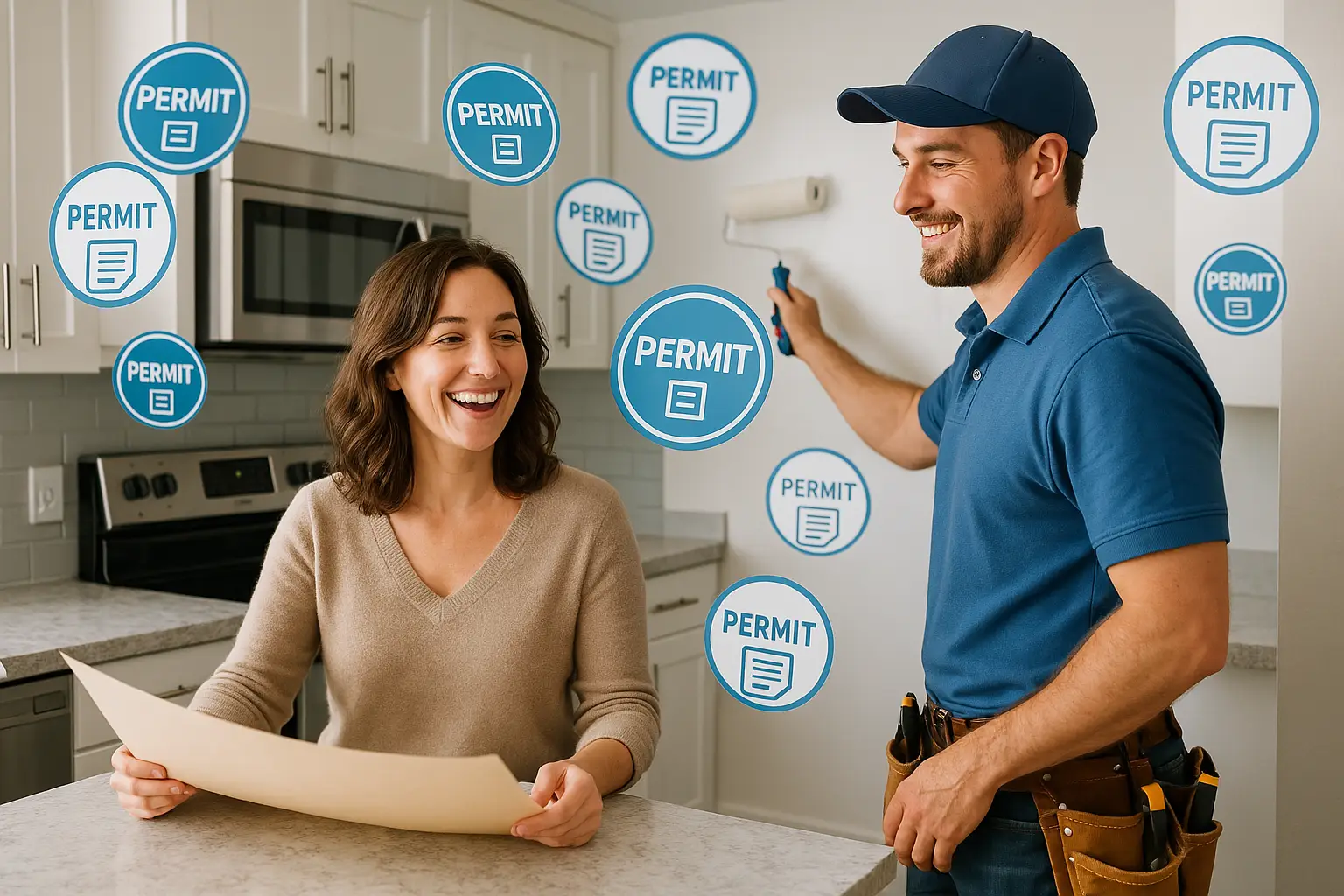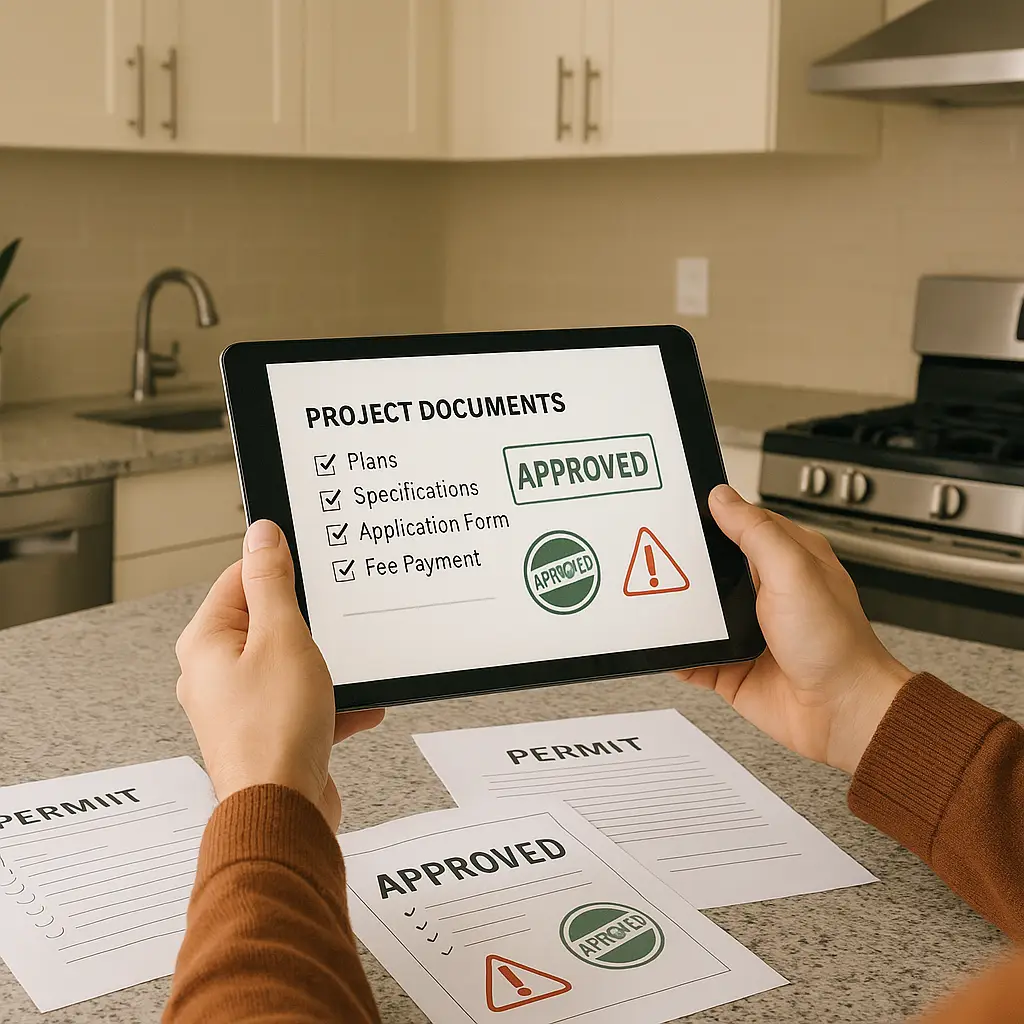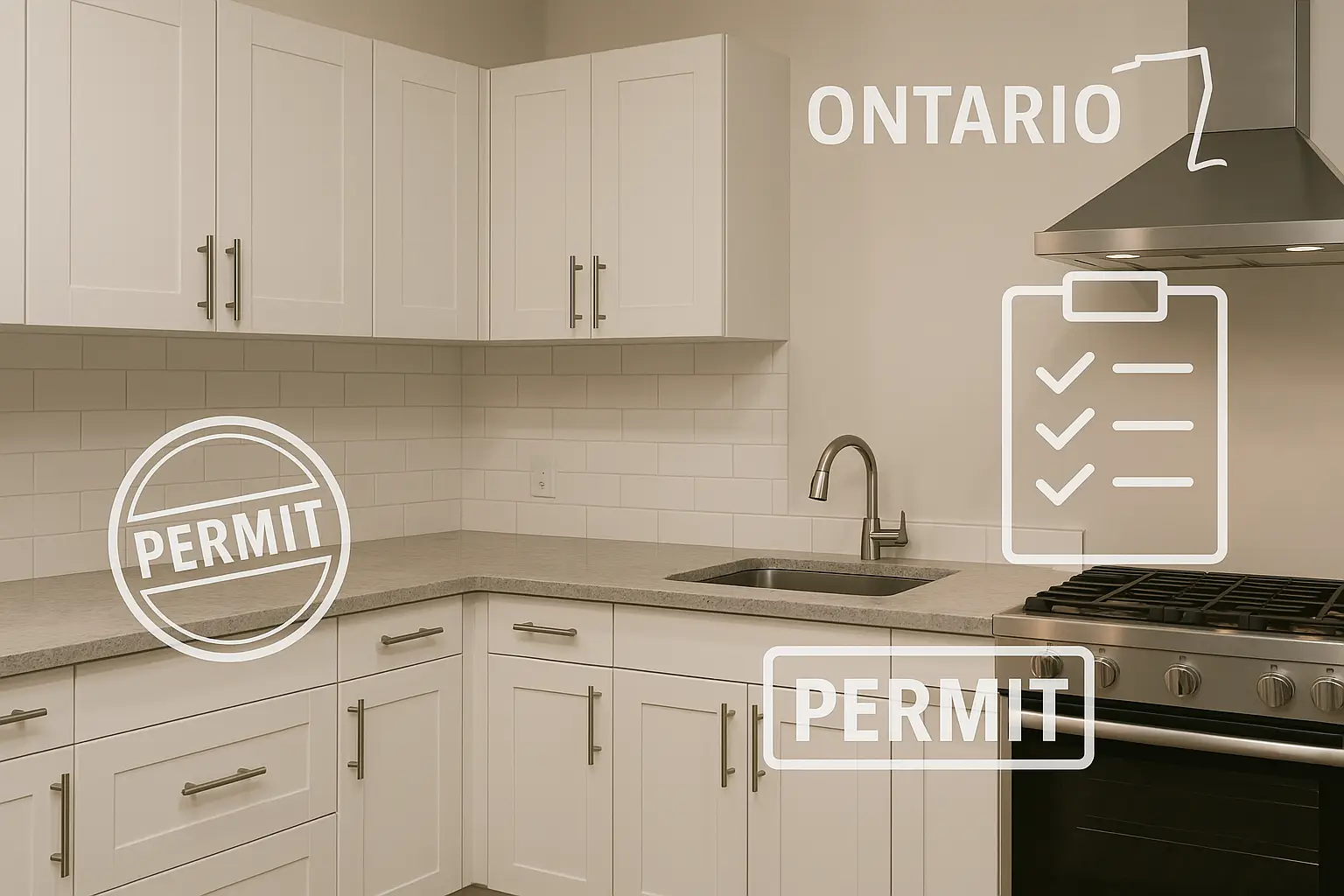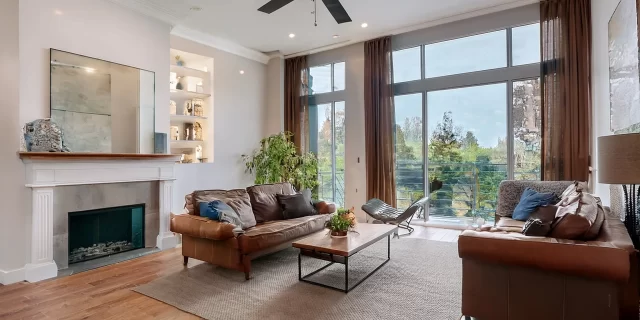Key Takeaways
- Proper permits are essential for kitchen renovations in Ontario to ensure compliance with local building codes and avoid legal issues. Most importantly, they protect your property value and make it easier to sell your home down the line.
- A kitchen renovation permit is a legal document that is granted by local governments. It helps to ensure that your project meets the requirements of the Ontario Building Code and safety requirements.
- Considering major renovation activities, such as structural changes, extensive plumbing rerouting and electrical work would likely need permitting. As a general rule, always consider the scope of your project to understand what will be required of it.
- Cosmetic renovations like painting, replacing cabinets, or upgrading an appliance in the same spot generally do not need permits. Always verify with local regulations to make sure you’re covered.
- Skipping the right permits can lead to unsafe conditions and fines, forced work stoppages, insurance hassles, and trouble selling your home. Make permits your first priority protecting your project and your investment.
- Start by checking your local building department, drawing up comprehensive kitchen renovation plans, and going through the right permit application process to ensure everything goes smoothly. Make sure you complete all required inspections so you’re playing by the rules from start to finish.
Why Kitchen Renovation Permits Matter
Getting in line with your local building code is more than a bureaucratic hoop to jump through – it’s the law. The Ontario Building Code has strict safety standards, and a permit helps ensure your renovation complies with the code. Renovating your home without the proper permits can cost you thousands in fines ranging from $198.59 to $27,234.64. You may find yourself suddenly having to halt your project while you get the required approvals in place.
Unless compromising structural or safety issues are found down the line, there may be no permanent consequences of fraudulent work, other than incurring fines. This is why Kozak Renovations provides a seamless experience by taking care of your permits. We help take the guesswork out of an overwhelming process.
Safety, after all, is the whole point of requiring permits and inspections. Permits protect the homeowner by making sure the work is completed according to industry-standard safety protocols. This protects everyone from hazards such as electrical shock, lack of plumbing, and lack of proper structural support. Without these eyes on your project, you are opening yourself up to a myriad of disasters from failed construction to wiped insurance coverages.
Homeowners in Ontario value the serenity that is derived from a stunning new kitchen. A kitchen that is safe, in addition to all that value, is truly invaluable. Our in-house team of licensed professionals – from electricians to plumbers – makes sure every detail is completed to exacting code.
Beyond the safety aspect, permits are important for protecting the value of your property. Many prospective buyers will ask for documentation showing that all renovations were completed legally and up to code. When a permit is missing, alarm bells go off, putting a timely and successful sale at risk.
By getting the necessary permits first, you show buyers that you value proper work and transparency, making future transactions smoother. Most recently, in October of this year, investors funneled more than $7 million through residential building permits. This out-sized investment represents their central role in protecting the integrity of properties.
What is a Kitchen Renovation Permit?
A kitchen renovation permit is an official authorization issued by the local government. This is a permit that is usually issued by your local municipality. It protects your home’s structural integrity and safety by ensuring your renovation plans comply with the Ontario Building Code.
It’s more than just being code compliant. In fact, it ensures that the work was done at a high caliber, providing you with a huge boost when you finally put your home on the market.
Kitchen renovation permits are more than a simple formality – they’re a fundamental step to the entire renovation process. The majority of kitchen renovation projects taking place in Ontario require a permit. This is particularly applicable if you’re altering load-bearing walls, moving utilities like plumbing or electrical systems, or doing extensive reconfiguration of the space. Failing to secure the necessary permits can lead to costly fines and complications down the line, including the potential to halt your renovation entirely. For those considering luxury kitchen renovations, adhering to permit regulations becomes even more crucial, as the scale and scope of these projects often involve intricate changes that must meet local building codes. Ensuring that all aspects of your renovation are properly documented and approved will not only provide peace of mind but also enhance the overall value of your home.
For example, moving a sink to a different spot in a kitchen or adding a new gas line would require these. Without securing a permit beforehand, you risk project delays and potentially costly repercussions, as municipalities can halt ongoing construction until proper authorization is obtained.
Making unpermitted work can leave you vulnerable to any insurance coverage disputes should structural issues develop in the future.
The application process is fairly simple, but it is all about the details. You can expect to submit detailed construction drawings, including lists of materials with total costs, to your local building department.
First off, here is how much you pay in Ottawa – $10.75 in permit fees per every $1,000 of construction value. That average includes all materials, labor, overhead, and professional fees.
After you file your application, it typically takes a review period of up to five business days. The overall timeline will largely depend on how complicated your renovation project is.
In October, Ottawa homeowners pumped more than $7 million into residential building permits. This is a sign that they understand the value of getting it right.
Providing timely information and feedback is crucial. Working with seasoned pros makes this easier. Contractors like ours take care of the permit application for you, ensuring your project stays on track and meets all legal requirements.
With compliance and quality in mind every step of the way, we ensure your renovation journey is easier, safer and hassle-free.
Do I Need a Permit?
1. Assess the Renovation Scope
The very first thing you should do is take an honest look at the scope of your project. Renovations that make structural alterations, like removing or moving load-bearing walls, almost always require a permit. Likewise, if your project affects core systems, such as plumbing or electrical wiring, permits are usually required.
For example, installing an open kitchen island with electrical outlets built in would not be approved without a permit. The nature of the system’s changes makes this demand necessary.
2. Structural Alterations and Permits
Whenever a renovation includes structural work, like modifying an existing foundation, shifting walls, or enlarging/adding spaces, a permit is necessary. Documenting these changes and getting them approved ensures your renovation meets modern-day safety standards.
For instance, replacing a non-load-bearing wall with a support beam requires adherence to very specific rules to preserve structural integrity.
3. Electrical Work and Permits
Electrical upgrades will need to conform to Ontario’s Electrical Safety Code. More than adding a few lightbulbs, installing new circuits or rewiring an entire house takes a permit and has to be done by licensed electricians.
Continuing to keep good records of electrical permits can help for future inspections and possible resale down the line.
4. Plumbing Changes and Permits
Major plumbing alterations, including moving existing pipes or adding new fixtures, usually need a permit. Consulting with your local plumbing code and having licensed plumbers do the work guarantees that your project will comply with safety standards.
For example, moving a sink to a different wall changes drainage systems and still requires an inspection.
5. Changing Layouts and Permits
If you’re changing the layout of your kitchen, such as moving walls or changing where appliances go, permits are usually needed. These changes may require alterations to existing plumbing and electrical systems, resulting in further permit requirements.
Comprehensive renovation plans make the approval process much smoother.
6. Cosmetic Upgrades – Permit Free?
Cosmetic updates, like painting, new countertops or new cabinetry, usually aren’t permit-triggering to begin with. Just make sure these improvements are legally defensible by checking local laws to prevent headaches down the line.
7. When in Doubt, Verify!
When in doubt, check with your local building department! This step avoids tragic mistakes, like the infraction of constructing without a permit that can lead to fines or invalidated insurance policies.
Maintaining a record of every communication helps avoid incoherence and finger pointing.
Renovations That Usually Need Permits
Moving or Removing Walls
Altering walls, especially load-bearing ones, necessitates a building permit. Load-bearing walls provide structural support, and removing or relocating them can impact the stability of your home.
For example, if you’re opening up your kitchen by removing a wall, structural assessments are crucial to determine if additional beams or supports are required. Consulting with a licensed contractor ensures all plans adhere to safety standards and local building codes.
Significant Plumbing Rerouting
Relocating plumbing fixtures like sinks, dishwashers, or gas lines usually needs a plumbing permit. These alterations may impact not only water pressure, but drainage, and the overall ability of a system to remain reliable.
As such, submission of detailed plans for renovation, including plans for plumbing adjustments, is required for approval. To meet Ontario’s plumbing safety code, only licensed plumbers can do this work. This way, you won’t get tripped up on a technicality in an upcoming inspection.
Extensive Electrical Changes
Substantial electrical renovations, such as rewiring or installing additional circuits, would need permits to meet Ontario’s Electrical Safety Code. Whether installing additional outlets for new appliances or updating old wiring, a licensed electrician must ensure the system is safe and compliant.
For future reference or resale of your home, keep all permits and inspection records on hand.
Structural Modifications
If your renovation includes changing structural elements, including beams, ceilings, and restoration of foundation, you will need a permit. For instance, installing a skylight or extending a window requires you to modify the internal support structure of your kitchen.
Extensive documentation needs to be provided to local officials in order to ensure compliance with health, safety and building codes.
Expanding the Kitchen Footprint
Expanding your kitchen’s footprint, either by gaining new square footage or modifying existing layouts, involves getting a building permit. These expansions might come with local zoning restrictions, so be sure to check your local bylaws.
Submit detailed plans to your local department of building safety for approval.
Renovations That Usually Don’t Need Permits
- Replacing kitchen cabinetry (if utilities remain unchanged)
- Updating kitchen countertops
- Upgrading kitchen appliances and hardware in the same location
- Installing new light fixtures
- Replacing kitchen flooring
- Painting and decorating
Replacing Cabinets
Replacing kitchen cabinets, when utilities such as plumbing and electrical connections are left untouched, usually does not require a permit. It’s essential to ensure that the new cabinets meet safety standards and align with current building codes.
For example, adequate clearance around stoves or sinks must be maintained. Documenting the cabinet replacement process, including receipts and product specifications, is a good practice for your records and future home value assessments.
Countertop Replacement
Installing new countertops is another easy update that usually doesn’t require a permit. New countertops should fit durable and safe standards – particularly in spaces with high usage, such as the kitchen.
Choose materials that are both food safe and heat resistant. Keeping a record of installation details, such as material warranties and installer information, ensures peace of mind and simplifies maintenance.
Minor Plumbing Repairs
Most small plumbing repairs, like changing a faucet or fixing a sink, don’t even need permits in Ontario. Fixing things within the confines of local plumbing code is important too, as the wrong repair might result in bigger problems down the road.
Take for instance the importance of proper sealing and drainage. Always document completed repairs, as this can be valuable for home inspections or future renovations.
Painting and Decorating
Cosmetic changes, including painting and other decorating, are the easiest renovations and need no permits. Even for interior paint jobs, choosing non-toxic, low-VOC paints will go a long way in creating a safer home.
Whenever you undertake big, dramatic changes and improvements – such as implementing ONE LARGE UNIQUE FEATURE WALL – this simple practice will save you time and headaches moving forward on all your projects.
Appliance Upgrades (Same Location)
Replacing or upgrading appliances usually doesn’t require a permit, as long as they stay in the same footprint – which is another common renovation that slips under the radar.
When buying new appliances, always select models that meet Ontario’s safety and energy efficiency standards. Having documentation for each upgrade, including model numbers and installation details, is important to protect any warranties and to provide to your homeowners insurance.
How to Obtain a Kitchen Renovation Permit
Research Local Building Codes
To start, get to know your municipality’s building codes and zoning bylaws. These codes set the standards for what is allowed in your renovation including structural repairs, plumbing work and electrical improvements.
To that end, in Ontario, compliance with the Zoning Bylaw is not optional. Create an outline of these requirements to inform your planning stage. In Ottawa, more detailed building code questions can be referred to Building Code Services through the 3-1-1 for further clarification.
Prepare Detailed Plans
These detailed plans are the foundation of a good permit application. Add inclusion architectural drawings, specifications, and a written description of your interior renovation work.
Be sure to include any layout changes and electrical work. Make sure your drawings conform to municipal code and mandated standards. For example, if we do electrical inspections, we need to comply with the Electrical Safety Authority (ESA) standards.
This level of planning drastically reduces the chance of an approval delay.
Complete the Application Form
Not sure what to include with your permit application form? Provide comprehensive project bids, from material take-off to projected job labor costs.
Review the entire application and all accompanying documents for accuracy and completeness. Mistakes can add additional review time. Keep in mind that the City of Ottawa usually requires five business days before approving and forwarding small project submissions.
Submit Required Documents
Submit your application with supporting documents, including plans, material estimates, and any pre-approvals. Maintain copies of this documentation for your own use.
Not having the proper documentation will set you back, so make sure you have everything they need from the start.
Pay Applicable Permit Fees
Permit fees commonly are based on the estimated project costs. For instance, Ottawa’s planning department charges $10.75 per $1,000 of construction value.
If payment isn’t received timely, it will cause interruptions to the review process. Save all invoices and receipts with detailed vendor information in your files.
Schedule Inspections
Inspections are important to ensure you’re following the rules at each step of your renovation. Work with your local authorities to pre-visit and plan for these checks along the way.
Keeping accurate records of inspection results helps you avoid delays or scaling back your project to get it completed.
Risks of Renovating Without a Permit
Fines and Penalties
Not only is it illegal, renovating without a permit comes with huge financial risks. In reality, local authorities can penalize between $198.59 and $27,234.64. The total fines can range from $11,000 per violation to $110,000 depending on the severity of the violation and the size of the project.
If you’re found to be non-compliant, you may face an extra penalty of up to 10% of your kitchen’s construction value. In addition to being unforeseen costs, these fines can really put a damper on your remodel journey. Having verified records of permits on file will help your project stay legal and save you the needless costs of permit violations.
Work Stoppage Orders
Unpermitted renovations quickly become vulnerable to major interruptions through work stoppage orders issued by local authorities. If the city discovers your project mid-construction, you’ll need to cease work right away.
Then it’s time to get the required permits and wait before you’re allowed to move forward. This lag time can be a major wrench in your renovation plans, spiking labor costs and interrupting daily lives. To prevent these delays, getting the appropriate permits before beginning your renovation will help you avoid an expensive, time-consuming halt in your plans.
Difficulty Selling Your Home
Additionally, unpermitted work can make it difficult to resell a home in the future. Buyers are understandably leery of homes with undocumented renovations, as they almost always indicate something dangerous and expensive lurking underneath.
Without permits, it’s hard to prove that your kitchen will adhere to building codes. Giving a concrete paper trail of approved renovations to prospective buyers instills confidence and protects your property value.
Insurance Complications
Homeowners’ insurance policies often explicitly list damages due to unpermitted work as excluded. Or worse, some claims can be denied completely, potentially leaving you to shoulder the financial burden in the case of an accident.
Safeguarding your investment means making sure that everything done is up to local codes and regulations and well-documented.
Safety Concerns
Not only can unpermitted renovations be an unsafe health risk. In addition, renovations done without following building codes can result in structural concerns or life-threatening hazards.
Focusing on compliance will make sure your new dream kitchen is a place your family can work safely. Incorporating safety measures into your kitchen design is essential, especially when it comes to the layout and materials you choose. While you may be tempted to follow every popular style, it’s important to be aware of kitchen trends to avoid that could compromise functionality or safety. Opting for open shelving, for instance, might look trendy, but it can lead to clutter and potential accidents if not organized properly.
Navigating Ontario’s Building Code
Navigating Ontario’s Building Code is the first step towards realizing any homeowner’s dream kitchen renovation. Consider it your roadmap to keeping your project safe, compliant and built to stand the test of time. Ontario’s Building Code establishes stringent, unambiguous standards for structural integrity, electrical, plumbing and fire systems.
These basic pieces are essential for a smart, as-of-right renovation to take root and flourish. In Ontario, you need to get a building permit for any significant alterations. This means extensive reconfiguration, often involving load-bearing walls, electrical systems, or plumbing layouts. This document ensures your renovation adheres to regional guidelines.
It protects your investment and more importantly, your family’s health. Developing a checklist of key Building Code regulations is critical to staying compliant throughout your renovation journey. Begin with your zoning regulations, the local laws that govern what types of modifications you can make where you live.
For instance, if you’re adding new fixtures or rearranging your kitchen layout, ensure these modifications meet the spatial and structural guidelines. Electrical systems and plumbing are to be held to high standards to prevent dangerous situations or expensive retrofits down the line.
Kozak Renovations simplifies this process by providing expert guidance and coordinating with local authorities, ensuring every detail aligns with the Building Code. This proactive approach helps avoid costly and time-consuming delays. Secondly, it protects corporations from facing significant fines, which can reach up to $1,500,000 for committing a Code violation.
Fulfilling your duty to adhere to the Building Code is more than just a legal requirement. It’s an affirmation that you pledge to creating safe, high-quality spaces. Inspections Permits automatically activate required inspections, which must occur within two business days of being flagged.
These timely inspections can help ensure that the work is up to safety codes, providing you with confidence as your project moves forward. Failing to take this step can result in unsafe structural conditions, denied claims from your insurance carrier, or decreased property value.
Kozak Renovations delivers transparency by taking care of all your permits and inspections, saving you time and allowing for a smooth compliance process. Additional information, including instructions for the homebuilding process, are available through municipal offices or online through Ontario’s e-Laws website.
These resources are full of useful information about the regulations and processes at play, giving you the tools you need to make smart, informed decisions.






